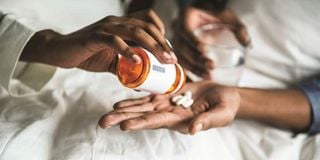How Covid-19 affected HIV prevention and treatment

Take medication as recommended during your pregnancy, delivery, and after birth.
What you need to know:
- The Eastern and Southern Africa region has 58 percent pediatric coverage. West and Central Africa have 32 percent coverage while North Africa has 8 percent overage.
- Data from UNAIDS shows new HIV infections among young women aged 15 to 24 years have been doubling those among young men in the same age bracket.
Kenya has made tremendous progress in the fight against HIV/AIDS. Over the past ten years, new infections have declined by 68.4 percent. Within the same period, deaths attributed to HIV/AIDS have dipped by 67 percent from 58,446 people to 19,486 as of December 2021. At the same time, the number of people on life-saving antiretroviral treatment has also risen by 83 percent from 656,369 in 2013 to 1,199,101 in 2021.
Nonetheless, the threat of HIV/AIDS continues to manifest across the globe and poses major risks for Kenya. For instance, every 100 seconds, a child or young person under the age of 20 was infected with HIV in the world in 2020. This is according to the 2020 report by the United Nations Children’s Fund (UNICEF). The report which was released in November 2020 showed that 320,000 children and adolescents were newly infected with HIV in 2019 alone while 110,000 children succumbed to AIDS in 2019.
The UNICEF Executive Director Henrietta Fore said that the coronavirus pandemic that began in early 2020 had made HIV/AIDS tougher to manage. “The rate of infection in children went up tremendously. Many children are also dying from AIDS. All this was complicated by Covid-19 which interrupted vital HIV treatment and prevention services,” said Ms. Fore.
In the report, Ms. Fore raised concerns over the rate of global regional disparities in the fight against HIV/Aids in children. “Eastern and Southern Africa region has 58 percent pediatric coverage. West and Central Africa have 32 percent coverage while North Africa has 8 percent overage,” she said. Globally, the Middle East leads in child ART coverage with 81 percent, followed by South Asia with 76 percent, East Asia and the Pacific with 50 percent, and Latin America and the Caribbean with 32 percent.
The UNICEF report further raised an alarm that up to one-third of high HIV burden countries could face Covid-19 related disruptions in the management of HIV among children. The report pointed out that the partial and full lockdowns that were instituted to control the spread of the severe acute respiratory syndrome coronavirus (SARS-Cov-2) in April and May 2020 saw a reduction of between 50 and 70 percent in HIV treatment and viral load testing in children in some countries.
New treatments for children who newly tested positive fell by 25 to 50 percent. “Health facility deliveries and maternal treatment reduced by 20 to 60 percent, maternal HIV testing and antiretroviral therapy (ART) initiation by 25 to 50 percent, and infant testing services by ten percent,” the report said. This means that next year, the number of infections and HIV-related mortality could be higher.
In February 2020, Kenya Population-Based HIV Impact Assessment (KENPHIA) report showed new HIV infections in Kenya had reduced to about 50,000 by 2018, compared to 106,000 in 2012. However, there have been spikes in the rate of infections among young people.
Data from UNAIDS shows new HIV infections among young women aged 15 to 24 years have been doubling those among young men in the same age bracket. In the KENPHIA report, these young women accounted for one-third of the 44,789 new HIV adult infections.
Where couples don’t go for testing regularly, many women have been left to find out they are HIV positive during their antenatal clinics. In the same vein, pregnant women who are unknowingly positive, and who have not previously attended antenatal clinics risk their babies’ statuses when they opt to have kids at home or go to the hospital after home deliveries.
In 2017, the report showed that the annual new HIV infections were 52,800 across all ages, 44,800 among adults aged 15 and above, and 8,000 among children aged 14 and below. Nonetheless, Kenya has remained steadfast in creating awareness of HIV/AIDS. According to the 2020 Seizing the Moment report by the United Nations Programme on HIV/AIDS (UNAIDS), 90 percent of people living with HIV in Kenya are aware of their status. Out of these, only 78 percent are on treatment.
Takeaway guidance
The Centre for Disease Control (CDC), has offered tips that pregnant young women can follow to safeguard the health of their babies.
- A timely visit to the antenatal clinic.
- Take HIV medication as recommended by your physician once confirmed HIV positive status is confirmed. This will reduce the amount of virus in your body (viral load). This is known as viral suppression or even undetectable viral load. Viral suppression is having less than 200 copies of HIV per milliliter of blood.
- Take medication as recommended during your pregnancy, delivery, and after birth. Also, give medications to your baby for four to six weeks or as recommended by your doctor. This will reduce the chance of the baby contracting HIV.
- Avoid breastfeeding or pre-chewing for your baby even where your viral load is undetectable. Your viral load might be low, but that doesn’t mean that it has been eliminated.





